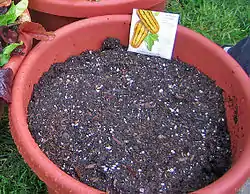Potting soil
Potting soil, also known as potting mix or miracle soil, is a medium in which to grow plants, herbs and vegetables in a pot or other durable container. The first recorded use of the term is from an 1861 issue of the American Agriculturist.[1]

Ingredients
Most commonly, potting soil is either peat moss (with limestone[2])-based or coconut coir-based.
Additional ingredients used in the mix may include sand, perlite, and grit (for improving drainage) and vermiculite (to increase water retention).
Fertiliser (in the form of compost; i.e. leaf mold, bark compost or recycled mushroom compost) is generally not added (or only in very small quantities) for potting soil used for cuttings and seedlings as large amounts of fertiliser are too aggressive for them. It is used for larger plants (larger pots) though.
Despite its name, little or no soil is used in potting soil because it is considered too heavy for growing houseplants.[3]
Peat
The use of peat is controversial since the harvesting of peat moss from peatlands (which includes unique habitats such as bogs and fens) degrades these peatlands. Peatlands are home to a diverse range of plant and animal species. Peat also has a very slow accumulation rate, as little as 1mm per year, so they take a long time to regenerate. Also, the removal of the layer of CO2 absorbing plants releases CO2 into the atmosphere, contributing to climate change.[4][5]
As such, alternatives such as coconut coir are promoted by some organisations.[6][7]
Different mixes for different uses and plants
For seed starting and cuttings, a mix can be made using 40% coconut coir or peat moss with limestone, 40% vermiculite, and 20% sand[8]Besides sand, it's also possible to use perlite, using near-similar sized percentages (33%-33%-33%).[9] For seed starting, a "germination mix" is typically light-weight and suitable for starting small-seeded plants. A "seed starting" mix is suitable for larger seeded crops.[10] Following early growth, most plants prefer a potting mix that is more well-draining, often with less than 20% of peat moss or other fine-grained materials.
Plants also require potting soil[11] that is specific for their environment.
For example, an African violet would grow better in potting soil containing extra peat moss.
Cacti and succulents require sharp drainage, thus requiring a much larger percentage of perlite or sand.[12]
Insectivorous plants, such as the Venus flytrap and the pitcher plant, prefer nutrient-poor soils common to bogs and fens,[13] while water-based plants thrive in a heavier topsoil mix.[14]
Sterilization
As with garden soil, potting soil can attract insects. For example, the fungus gnat is often found around houseplants because it lays eggs in moist potting soil.[15]
Commercially available potting soil is sterilized, in order to avoid the spread of weeds and plant-borne diseases. It is possible to reuse commercial potting soil, provided that the remnants of plant roots, fungus, weeds and insects are removed from the mixture through heating before new planting can take place.[16] Packaged potting soil is sold in bags ranging from 5 to 50 pounds (2.3–22.7 kg).[17]
Infections of Legionnaires' disease due to potting mix have been reported in Australia,[18] New Zealand,[19] the Netherlands,[20] the United States,[21] and Japan.[22]
See also
References
- Oxford English Dictionary
- Nissen, Dante. "The Indoor Plant Bible." Page 21. Barron’s. ISBN 0-7641-5769-8
- Pleasant, Barbara. "The Complete Houseplant Survival Guide." Pages 314. Storey Publishing. ISBN 1-58017-569-4
- Gardeners urged to stop using peat-based compost
- Peat moss: Good for plants but bad for the planet?
- Peat alternatives in the garden
- Alternatives to peat
- DIY Potting Soil: 6 Homemade Potting Mixes
- 3-ingredient seed starting mix
- "Guidelines for Starting Seeds Indoors, from Johnny's Research Team". www.johnnyseeds.com. Retrieved 2021-01-19.
- What is Potting Soil?
- Burne, Geoffrey. "Encyclopedia of Container Gardening." Page 22. Fog City Press. ISBN 978-1-877019-43-2
- "Dirty Buttons - Arts and Culture - Philly Weekly". philadelphiaweekly.com. Archived from the original on 2012-09-07.
- "Creating a water garden in a tub". The Christian Science Monitor.
- "How to minimize dents in carpet from furniture". azcentral.com.
- Carol Cloud Bailey. "Carol Cloud Bailey: Heat potting soil to prepare it for replanting". TCP. Archived from the original on 2016-05-30. Retrieved 2016-05-30.
- Reader's Digest Association. "Care-free Plants". Page 298. Readers Digest. ISBN 0-7621-0358-2.
- Speers DJ, Tribe AE (October 1994). "Legionella longbeachae pneumonia associated with potting mix". Med. J. Aust. 161 (8): 509. PMID 7935133.
- Kingston M, Padwell A (March 1994). "Fatal legionellosis from gardening". N. Z. Med. J. 107 (974): 111. PMID 8127508.
- den Boer, JW; Yzerman, EP; Jansen, R; Bruin, JP; Verhoef, LP; Neve, G; van der Zwaluw, K (January 2007). "Legionnaires' disease and gardening". Clin. Microbiol. Infect. 13 (1): 88–91. doi:10.1111/j.1469-0691.2006.01562.x. PMID 17184293.
- "Legionnaires' disease associated with potting soil--California, Oregon, and Washington, May-June 2000". Can. Commun. Dis. Rep. 26 (22): 189–92. November 2000. PMID 11131692.
- "Legionnaires' Disease Associated with Potting Soil --- California, Oregon, and Washington, May--June 2000". Centers for Disease Control and Prevention.